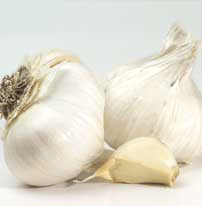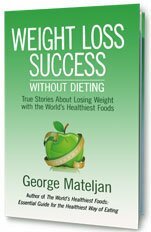
|
|
March 5, 2013
|
|
Check Out What's New On Our Website
 Find out how to keep your New Year's resolution and lose those extra pounds with our Weight Loss Success-Without Dieting book. Take advantage of our special offer and save $7.00. You pay only $17.00!What's New in 2013 Find out how to keep your New Year's resolution and lose those extra pounds with our Weight Loss Success-Without Dieting book. Take advantage of our special offer and save $7.00. You pay only $17.00!What's New in 2013
healthy food tip and recipe
Today's Recipe
If you don't know what to serve for dinner tonight ... The combination of ingredients in this recipe offers a delicious flavor while providing you with an excellent source of health-promoting nutrients. And you can enjoy a complete meal in 30 minutes. 
Ingredients:
In-Depth Nutritional Profile for Braised Cod with Celery Healthy Food Tip
The Latest News about Garlic
For a small vegetable, garlic (Allium sativum) sure has a
big, and well deserved, reputation. And although garlic may not always
bring good luck, protect against evil, or ward off vampires,
characteristics to which it has been assigned folklorically, it is
guaranteed to transform any meal into a bold, aromatic, and healthy
culinary experience. Garlic is a member of the Lily family and is a
cousin to onions, leeks and chives.
What's New and Beneficial About Garlic
WHFoods Recommendations
With their unique combination of flavonoids and sulfur-containing
nutrients, allium vegetables-such as garlic-belong in your diet on a
regular basis. There's research evidence for including at least one
serving of an allium vegetable-such as garlic-in your meal plan every
day. If you're choosing garlic as your allium family vegetable, try to
include at least ½ clove in your individual food portion. If you're
preparing a recipe, we recommend at least 1-2 cloves.
Garlic is a wonderful seasoning to add aroma, taste, and added nutrition to your dishes. We often recommend using raw chopped or pressed garlic in many of our dishes to take advantage of the benefits derived from garlic. However, if you cannot tolerate raw garlic, you can add chopped garlic to foods while they are cooking. It is best to add it towards the end of the cooking process to retain the maximum amount of flavor and nutrition.
Health Benefits
Garlic provides numerous health benefits including:
Nutritional Profile
The sulfur compounds in garlic are perhaps its most unique nutrients.
There are literally dozens of well-studied sulfur molecules in garlic,
and virtually all of them have been shown to function as antioxidants.
In addition, many provide us with anti-inflammatory benefits. The very
presence of sulfur in some many different garlic compounds may also play
an important role in our nourishment.
Additionally, garlic is an excellent source of bone-healthy manganese. It is also a very good source of heart-healthy vitamin B6 and vitamin C. In addition, garlic is a good source of muscle-promoting protein; energy-supporting thiamin (vitamin B1) and phosphorus; inflammation-reducing selenium; and bone-supporting calcium, potassium, and copper. For more on this nutrient-rich food, including references related to this Latest News, see our write-up on garlic. | |
“It’s really important that you feel good. Because this feeling good is what goes out as a signal into the universe and starts to attract more of itself to you. So the more you can feel good, the more you will attract the things that help you feel good and that will keep bringing you up higher and higher” – Joe Vitale
Wednesday, March 6, 2013
Braised Cod with Celery - A Healthly Recipe
Subscribe to:
Post Comments (Atom)
God
God, Grant me the serenity to accept the things I cannot change, The courage to change the things I can, The wisdom to know the differen...
-
Having als is no fun. It is a very hard illness to accept. Nothing prepares you for it. Been diagnosed with it almost a year and half ag...
-
I need feedback on which logos you like the best: Image by Cool Text: Free Graphics Generator - Edit Image Image by Cool Text: Free Lo...

No comments:
Post a Comment